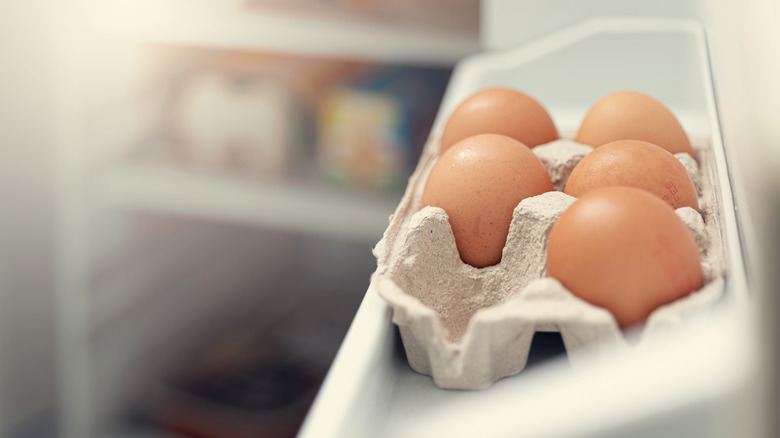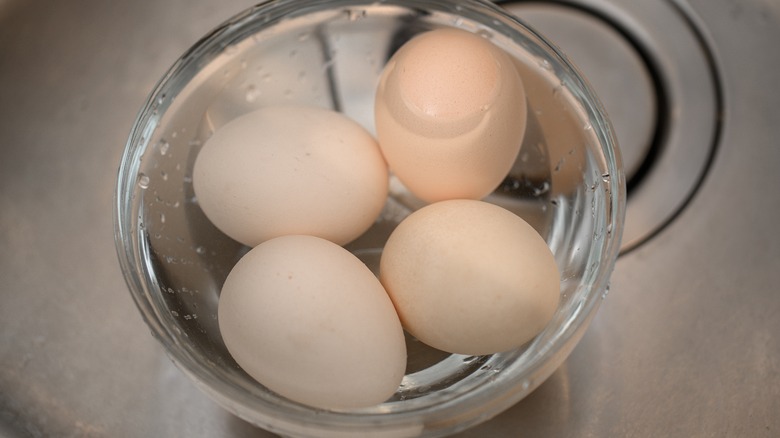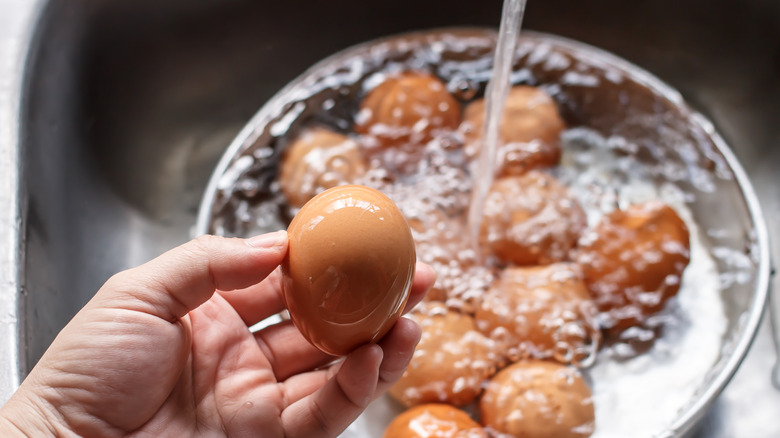The Best Way To Bring Eggs To Room Temperature Without Safety Risks
You're all set to bake your favorite dessert, but the eggs are still sitting in the fridge. As an old hand at baking, you know the best chocolate chip cookies involve room-temperature eggs. So what do you do? It could take a half hour or more for eggs sitting on the counter to come to room temperature while everything else is ready now. Besides, it's easy to get distracted — and the USDA says you absolutely should not leave eggs at room temperature for more than two hours. Once food exceeds 40 degrees Fahrenheit, it becomes easier for harmful bacteria to flourish. At that point, two hours is all you've got before it's recommended you throw the eggs out; if the ambient temperature is above 90 degrees Fahrenheit, cut that time to one hour. With refrigerated eggs in particular, the USDA notes that condensation or "sweat" can form on the porous egg shells sitting on the counter and draw bacteria inside the egg. Consider two hours the hard deadline.
Fortunately, there are a few options for safely and quickly warming your eggs to where you want them. Which method you use depends a lot on personal preference. Microwaving is probably the quickest, but it's generally not recommended since it's so inconsistent. Are the eggs warming or accidentally cooking? Instead, go for the best option: a warm water bath. Soaking refrigerated eggs in a cup or bowl full of warm or hot (not boiling) water gets perfect results in as little as 10 minutes.
Bring eggs to room temperature with warm water
There are several issues (in addition to time) that make simply leaving eggs on the counter less than ideal. If they're sitting in a bowl, the eggs in the middle will be insulated by their neighbors and warm up more slowly. If they're sitting on a stone countertop, the cool material can also lead to inconsistent warming.
Instead, immerse eggs in warm water. Using a cup or bowl large enough to fully submerge the eggs, run the tap warm but not super hot or boiling: You're not making hard-boiled eggs, after all. In 10 to 15 minutes, they'll be ready (one or two eggs might take as little as five minutes). To speed up the process, replace the water halfway through and rearrange the eggs. You can also put the bowl in the sink and run a steady stream of warm water over it.
Use warmed eggs as soon as possible after removing them from the water, because you've now brought them up to a temperature that invites harmful bacteria to rapidly multiply if they sit around for too long. This technique doesn't just help with baking, room-temperature eggs make for fantastic fried eggs as well. There's another advantage, too: The warmer eggshells are easier to crack, improving that part of the process.
Other options for warming eggs safely
Another technique for bringing your eggs to room temperature involves covering them with a warm or hot bowl. Heat up the bowl in the microwave for a minute or two, or fill it with very hot water, emptying it just before use. Place the hot bowl over the eggs where it will emit and contain the heat, quickly warming up your golden treasures. Just be sure to use potholders when handling the bowl.
Fresh eggs from a coop may already be at room temperature since you don't have to refrigerate untreated eggs, like those in Britain. Still, wash them free of any feathers or waste in warm water just before using. Pre-washing treated American eggs with cold water isn't recommended by the USDA. Without that natural protective coat, water can be sucked into the pores, along with any harmful bacteria on your hands or the surface of the egg. Warm water, on the other hand, makes the egg expand, limiting bacteria from entering those pores.
If the recipe you're following calls for separating yolks and whites, do it before bringing your eggs to room temperature. Chilled yolks are more stable and easier to work with. Separate the yolks and whites into different bowls, then place the bowls into a pot filled with hot water that falls below their rims; in this case, the water should be as hot as possible, since it has to warm the eggs through the bowls. Stir occasionally for about five minutes.


